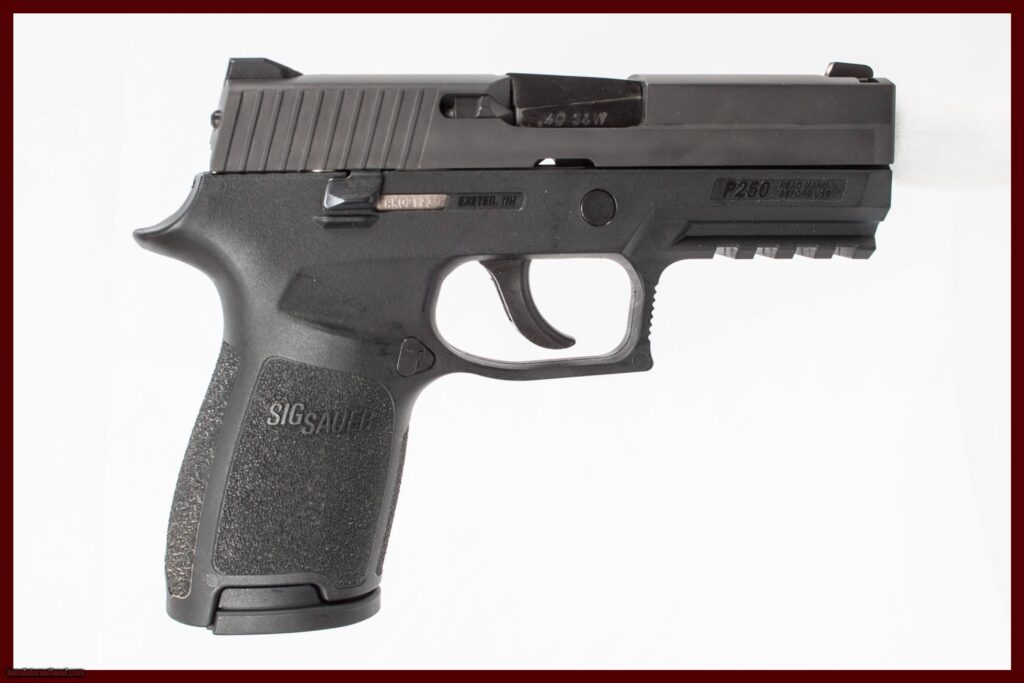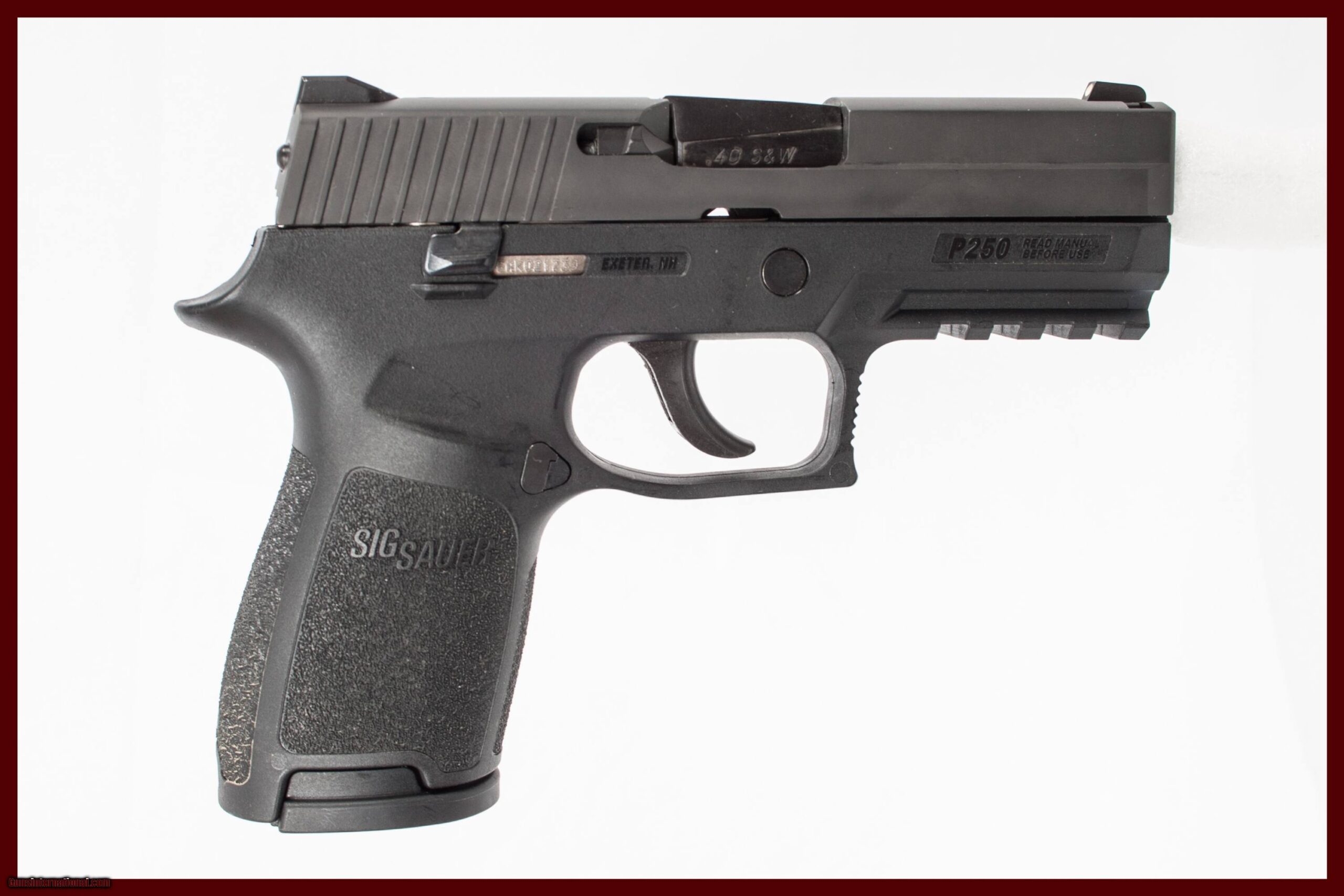
Sig Sauer P250 .40: A Comprehensive Overview of a Modular Handgun
The Sig Sauer P250 .40 is a modular handgun known for its versatility and adaptability. Chambered in the potent .40 S&W cartridge, it offers a balance of manageable recoil and significant stopping power, making it a popular choice for law enforcement, personal defense, and sport shooting. This article delves into the features, performance, history, and overall appeal of the Sig Sauer P250 .40, providing a comprehensive overview for both seasoned firearm enthusiasts and those new to the world of handguns.
The Modularity of the Sig Sauer P250
One of the defining characteristics of the Sig Sauer P250 is its modular design. The firearm consists of a serialized receiver, also known as the fire control unit (FCU), which can be swapped between different grip modules (frames), slides, and barrels. This allows the user to configure the handgun to their specific needs and preferences. The Sig P250 .40, in particular, benefits from this modularity, as the .40 S&W cartridge can be a bit snappy in smaller frames. The ability to choose a larger grip module can improve handling and reduce felt recoil.
Understanding the Fire Control Unit (FCU)
The FCU is the heart of the Sig Sauer P250. It contains the trigger mechanism, sear, and other critical components required for firing. Because it is the serialized part, it is considered the firearm by legal definition. This means that you can purchase different grip modules, slides, and barrels without needing to go through a background check for each component. The FCU of the Sig P250 .40 is designed for reliability and consistent performance, ensuring proper function with the .40 S&W cartridge.
Grip Modules: Customizing the Feel
The grip module is the polymer frame that houses the FCU. The Sig Sauer P250 .40 offers a variety of grip module sizes, including subcompact, compact, and full-size. Each size offers a different grip circumference and length, allowing users to find the perfect fit for their hand. A proper grip is crucial for accurate shooting and recoil management, especially with a caliber like .40 S&W. The ability to customize the grip module is a significant advantage of the Sig P250.
Slide and Barrel Options
While the Sig P250 .40 is primarily chambered in .40 S&W, the modular design allows for conversion to other calibers, although this typically requires a different slide and barrel. However, within the .40 S&W configuration, users can choose different slide lengths and finishes. The barrel length typically corresponds to the grip module size, with full-size models having longer barrels for increased accuracy and velocity. The Sig Sauer P250 .40 slide is typically made of stainless steel and features a Nitron finish for enhanced durability and corrosion resistance.
Performance and Handling of the P250 .40
The Sig Sauer P250 .40 offers a balance of power and shootability. The .40 S&W cartridge delivers significant energy on target, making it an effective choice for self-defense. However, it also produces more recoil than 9mm, requiring proper technique and grip to control effectively. The P250’s ergonomics, particularly the grip module options, play a crucial role in managing recoil and maintaining accuracy.
Recoil Management
Recoil management is a key consideration when shooting the Sig P250 .40. The .40 S&W cartridge generates a noticeable amount of recoil, which can affect accuracy and shooting speed. Proper grip technique, including a firm hold and high grip position, is essential for controlling the handgun. The larger grip modules can also help to distribute recoil more evenly across the hand, reducing felt recoil. Additionally, practicing with the Sig Sauer P250 .40 regularly will improve your ability to manage recoil and maintain accuracy.
Accuracy and Reliability
The Sig Sauer P250 .40 is known for its accuracy and reliability. The handgun’s trigger pull is consistent and smooth, contributing to accurate shooting. The P250 features a double-action-only (DAO) trigger system, which means that the trigger pull is the same for every shot. While some shooters prefer other trigger systems, the DAO trigger on the Sig P250 .40 is designed for safety and reliability. Regular maintenance and cleaning are essential for maintaining the handgun’s reliability. [See also: Handgun Maintenance Guide]
Stopping Power of .40 S&W
The .40 S&W cartridge is often chosen for its stopping power. It offers a good balance between the 9mm and .45 ACP in terms of energy and penetration. While the debate over the best self-defense caliber continues, the .40 S&W has proven to be effective in real-world scenarios. The Sig Sauer P250 .40 chambered in .40 S&W provides users with confidence in their ability to stop a threat. The Sig P250 .40’s inherent reliability makes it a suitable choice for a defensive firearm.
History and Development
The Sig Sauer P250 was first introduced in 2007 as a modular handgun platform. It was designed to offer users a customizable and versatile firearm that could be adapted to different needs and preferences. The Sig Sauer P250 .40 was one of the initial caliber options offered, alongside 9mm and .45 ACP. While the P250 has since been discontinued by Sig Sauer, it remains a popular choice among firearm enthusiasts due to its modularity and availability on the used market. The Sig P250 .40 holds its own as a solid, reliable option.
Evolution of Sig Sauer Handguns
The Sig Sauer P250 represents a significant step in the evolution of Sig Sauer handguns. It introduced the concept of modularity, which has since been incorporated into other Sig Sauer models, such as the P320. The P250 paved the way for more customizable and adaptable firearms, reflecting the changing needs and preferences of shooters. The Sig Sauer P250 .40, in particular, showcased the company’s commitment to providing reliable and effective handguns in a variety of calibers.
Discontinuation and Legacy
Despite being discontinued, the Sig Sauer P250 .40 continues to have a following among firearm enthusiasts. Its modularity, reliability, and the potent .40 S&W cartridge make it a desirable handgun for self-defense, sport shooting, and collecting. The P250’s legacy lives on in the modular designs of subsequent Sig Sauer handguns, demonstrating its impact on the firearm industry. The Sig P250 .40’s influence is undeniable.
Pros and Cons of the Sig Sauer P250 .40
Like any firearm, the Sig Sauer P250 .40 has its pros and cons. Understanding these advantages and disadvantages is essential for making an informed decision about whether this handgun is the right choice for you.
Advantages
- Modularity: The ability to swap grip modules, slides, and barrels allows for customization and adaptability.
- Stopping Power: The .40 S&W cartridge delivers significant energy on target.
- Reliability: The P250 is known for its consistent and dependable performance.
- Availability: While discontinued, P250s are readily available on the used market.
Disadvantages
- Recoil: The .40 S&W cartridge produces more recoil than 9mm, requiring proper technique.
- DAO Trigger: The double-action-only trigger may not be preferred by all shooters.
- Size: Depending on the grip module, the P250 can be bulky for concealed carry.
- Discontinuation: Parts availability may become an issue in the future.
Conclusion: Is the Sig Sauer P250 .40 Right for You?
The Sig Sauer P250 .40 is a versatile and reliable handgun that offers a balance of power and shootability. Its modular design allows for customization, while the .40 S&W cartridge provides significant stopping power. However, the recoil and DAO trigger may not be suitable for all shooters. Ultimately, the decision of whether to purchase a Sig Sauer P250 .40 depends on your individual needs, preferences, and shooting experience. If you are looking for a modular handgun chambered in a potent caliber, the Sig P250 .40 is worth considering. Before purchasing, it is recommended to handle and shoot the handgun to determine if it is a good fit for you. [See also: Choosing the Right Handgun]

